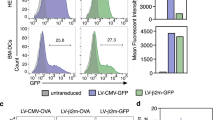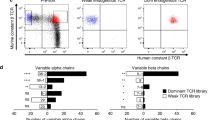Abstract
Strong cell-type-specific promoters are basic tools in gene therapy allowing for novel applications and focused strategies by transcriptionally targeting gene expression to selected cells. In immunotherapy, dendritic cells (DC) are of central importance, since they represent the principal inducers of immune responses. Here we describe isolation and use of the promoter of the murine actin-bundling protein fascin to target transcriptionally gene expression to cutaneous DC. Using the reporter gene enhanced green fluorescent protein (EGFP), we demonstrate that the fascin promoter mediates a strong antigen expression that is restricted to mature DC. DNA vaccination with antigen-encoding expression vectors under control of the fascin promoter using a gene gun resulted, consistently, in limited antigen expression by few directly transfected DC. Nevertheless, nearly as many antigen-specific CD8+ T cells directed against the encoded antigens EGFP and β-galactosidase, respectively, were induced as with expression constructs under control of the ubiquitously expressed CMV promoter. This result impressively underlines the pivotal role of directly transfected DC in DNA vaccination. Immunization using the fascin promoter induced markedly lower levels of antigen-specific antibodies following single or repeated immunization. Thus, our DC-targeted DNA vaccination approach induces qualitatively distinct, predominantly cellular immune responses and provides new opportunities for immunotherapy.
This is a preview of subscription content, access via your institution
Access options
Subscribe to this journal
Receive 12 print issues and online access
$259.00 per year
only $21.58 per issue
Buy this article
- Purchase on Springer Link
- Instant access to full article PDF
Prices may be subject to local taxes which are calculated during checkout



Similar content being viewed by others
References
Banchereau J, Steinman RM . Dendritic cells and the control of immunity. Nature 1998; 392: 245–252.
Tüting T, DeLeo AB, Lotze MT, Storkus WJ . Genetically modified bone marrow-derived dendritic cells expressing tumor-associated viral or ‘self’ antigens induce antitumor immunity in vivo. Eur J Immunol 1997; 27: 2702–2707.
Timares L, Takashima A, Johnston SA . Quantitative analysis of the immunopotency of genetically transfected dendritic cells. Proc Natl Acad Sci USA 1998; 95: 13147–13152.
Kündig TM et al. Fibroblasts as efficient antigen-presenting cells in lymphoid organs. Science 1995; 268: 1343–1347.
Nickoloff BJ, Turka LA . Immunological functions of non-professional antigen-presenting cells: new insights from studies of T-cell interactions with keratinocytes. Immunol Today 1994; 15: 464–469.
Gaspari AA, Katz SI . Induction of in vivo hyporesponsiveness to contact allergens by hapten-modified Ia+ keratinocytes. J Immunol 1991; 147: 4155–4161.
Ross R et al. The actin-bundling protein fascin is involved in the formation of dendritic processes in maturing epidermal Langerhans cells. J Immunol 1998; 160: 3776–3782.
Ross R et al. Mouse Langerhans cells differentially express an activated T cell-attracting CC chemokine. J Invest Dermatol 1999; 113: 991–998.
Ross R et al. Expression of the actin-bundling protein fascin in cultured human dendritic cells correlates with dendritic morphology and cell differentiation. J Invest Dermatol 2000; 115: 658–663.
Jaffe R, DeVaughn D, Langhoff E . Fascin and the differential diagnosis of childhood histiocytic lesions. Pediatr Dev Pathol 1998; 1: 216–221.
Tang DC, DeVit M, Johnston SA . Genetic immunization is a simple method for eliciting an immune response. Nature 1992; 356: 152–154.
Condon C et al. DNA-based immunization by in vivo transfection of dendritic cells. Nat Med 1996; 2: 1122–1128.
Porgador A et al. Predominant role for directly transfected dendritic cells in antigen presentation to CD8+ T cells after gene gun immunization. J Exp Med 1998; 188: 1075–1082.
Shen Z, Reznikoff G, Dranoff G, Rock KL . Cloned dendritic cells can present exogenous antigens on both MHC class I and class II molecules. J Immunol 1997; 158: 2723–2730.
Xu S et al. Successive generation of antigen-presenting, dendritic cell lines from murine epidermis. J Immunol 1995; 154: 2697–2705.
Valladeau J et al. Identification of mouse langerin/CD207 in Langerhans cells and some dendritic cells of lymphoid tissues. J Immunol 2002; 168: 782–792.
Gambotto A et al. Immunogenicity of enhanced green fluorescent protein (EGFP) in BALB/c mice: identification of an H2-Kd-restricted CTL epitope. Gene Therapy 2000; 7: 2036–2040.
Steitz J, Brück J, Knop J, Tüting T . Adenovirus-transduced dendritic cells stimulate cellular immunity to melanoma via a CD4(+) T cell-dependent mechanism. Gene Therapy 2001; 8: 1255–1263.
Morita A et al. Development of a Langerhans cell-targeted gene therapy format using a dendritic cell-specific promoter. Gene Therapy 2001; 8: 1729–1737.
Cho JH, Youn JW, Sung YC . Cross-priming as a predominant mechanism for inducing CD8+ T cell responses in gene gun DNA immunization. J Immunol 2001; 167: 5549–5557.
Brocker T, Riedinger M, Karjalainen K . Targeted expression of major histocompatibility complex (MHC) class II molecules demonstrates that dendritic cells can induce negative but not positive selection of thymocytes in vivo. J Exp Med 1997; 185: 541–550.
Jonuleit H et al. Induction of interleukin 10-producing, nonproliferating CD4(+) T cells with regulatory properties by repetitive stimulation with allogeneic immature human dendritic cells. J Exp Med 2000; 192: 1213–1222.
Ochsenbein AF et al. Roles of tumour localization, second signals and cross priming in cytotoxic T-cell induction. Nature 2001; 411: 1058–1064.
Ross R et al. Nonradioactive detection of differentially expressed genes using complex RNA or DNA hybridization probes. Biotechniques 1999; 26: 150–155.
Sudowe S, Rademaekers A, Kölsch E . Antigen dose-dependent predominance of either direct or sequential switch in IgE antibody responses. Immunology 1997; 91: 464–472.
Acknowledgements
This work was supported by the Deutsche Forschungsgemeinschaft, SFB 548 and SFB 432. We thank Dr Albert DeLeo (University of Pittsburgh School of Medicine, Pittsburgh, PA, USA) for providing the EGFP peptide, Dr Kenneth Rock (UMass Medical School, Worcester, MA, USA) for providing the cell line DC2.4, Drs Sem Saeland and Giorgio Trinchieri (both Schering-Plough Laboratory for Immunological Research, Dardilly, France) for providing the anti-langerin antibody 929F3 and Dr Akira Takashima (University of Texas Southwestern Medical Center, Dallas, TX, USA) for providing the cell line XS52. The expert technical assistance of Ms Katrin Krause & Ms Nadine Wiechmann is gratefully acknowledged.
Author information
Authors and Affiliations
Rights and permissions
About this article
Cite this article
Ross, R., Sudowe, S., Beisner, J. et al. Transcriptional targeting of dendritic cells for gene therapy using the promoter of the cytoskeletal protein fascin. Gene Ther 10, 1035–1040 (2003). https://doi.org/10.1038/sj.gt.3301968
Received:
Accepted:
Published:
Issue Date:
DOI: https://doi.org/10.1038/sj.gt.3301968
Keywords
This article is cited by
-
Inhibition of antigen-specific immune responses by co-application of an indoleamine 2,3-dioxygenase (IDO)-encoding vector requires antigen transgene expression focused on dendritic cells
Amino Acids (2020)
-
Targeting dendritic cells with antigen via dendritic cell-associated promoters
Cancer Gene Therapy (2012)
-
Comparison of immune response generated against Japanese encephalitis virus envelope protein expressed by DNA vaccines under macrophage associated versus ubiquitous expression promoters
Virology Journal (2011)
-
Comparative analysis of macrophage associated vectors for use in genetic vaccine
Genetic Vaccines and Therapy (2011)
-
Fascin
AfCS-Nature Molecule Pages (2010)



